Atlantic Sharpnose Shark
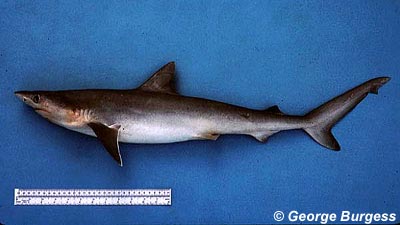
Rhizoprionodon terraenovae
This small, slim shark rarely grows more than 3.5 feet long, and has a distinctly long, pointed snout, and large eyes. It likes to forage in surf zones and estuaries, so it comes into contact with humans frequently. It is not considered dangerous though because most bites are non-fatal and not serious. Of requiem sharks, this one fares better in captivity and is sometimes featured in public aquariums.
Order – Carcharhiniformes
Family – Carcharhinidae
Genus – Rhizoprionodon
Species – terraenovae
Common Names
Atlantic sharpnose sharks get their name from a characteristically long snout, which is longer than the width of the mouth. English language common names are Atlantic sharpnose shark, Newfoundland shark, sharp-nosed shark, and white shark. Other names include Atlantische scherpsnuithaai (Dutch), bicudo (Portuguese), cação-alecrim (Portuguese), cação-de-bico-doce (Portuguese), cação-fidalgo (Portuguese), cazón (Spanish), cazón chino (Spanish), cazón de ley (Spanish), cazón picudo atlántico (Spanish), chien de mer (French), cucuri (Portuguese), cuur (Wolof), frango (Portuguese), requin à nez pointu (French), requin aiguille gussi (French), squalo di terranuova (Italian), tollito (Spanish), tollo hocicón (Spanish), and tubarao-terranova (Portuguese).
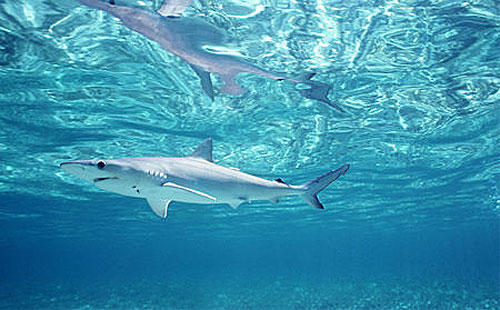
Importance to Humans
Both small and large coastal shark fisheries along the Atlantic coast of the U.S. target Atlantic sharpnose sharks. The meat is sold for human consumption as well as used by fishers as bait to other larger species of shark. The small fin size makes them less valuable to commercial fishers than other species of shark such as the sandbar (Carcharhinus plumbeus), and hammerheads (family Sphyrnidae). Despite their reduced value, Atlantic sharpnose sharks are caught in large quantities and represent the most commonly caught small coastal shark species. A large number of sharpnose sharks are also taken as bycatch in the shrimp fisheries.
Danger to Humans
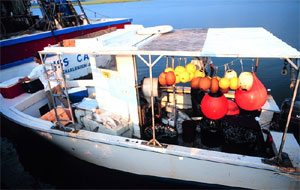
Atlantic sharpnose sharks pose a moderate threat to humans. Because of their choice of habitat, they often come into contact with humans. However, most bites inflicted on humans by this shark are nonfatal and not serious.
Conservation
The Atlantic sharpnose shark is listed as “Least Concern” by the World Conservation Union (IUCN) due to its abundance within its western North Atlantic range. The IUCN is a global union of states, governmental agencies, and non-governmental organizations in a partnership that assesses the conservation status of species.
> Check the status of the Atlantic sharpnose shark at the IUCN website.
Currently, in U.S. waters, there is a limit of one Atlantic sharpnose shark per person per trip for recreational fishers.
Geographical Distribution
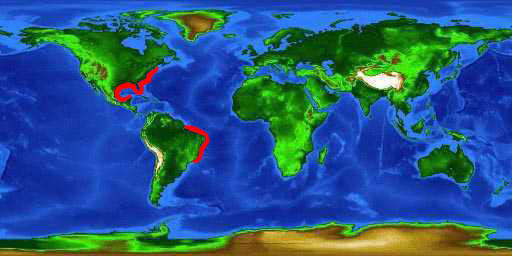
The Atlantic sharpnose shark is commonly found from New Brunswick, Canada, through the Gulf of Mexico as well as along the coast of Brazil.
Habitat
This shark commonly inhabits both warm-temperate and tropical waters from the Bay of Fundy to the Yucatan. As year round residents off the shore of South Carolina, Florida, and the Florida Keys, this species shows regular inshore to offshore migrations. Atlantic sharpnose sharks have been observed to form large sexually segregated schools during migrations. As winter approaches, the sharks move offshore into deeper water, returning inshore to mate in spring and give birth after a 10-11 month gestation period. They are found at depths to 920 feet (280 m), but mostly remain in waters less than 32 feet (10 m) deep. Along with being common residents of the surf zone, the Atlantic sharpnose shark is also found in estuaries and harbors. Although this shark is able to tolerate lower salinity levels, they do not venture into freshwater like the bull shark (Carcharhinus leucas).
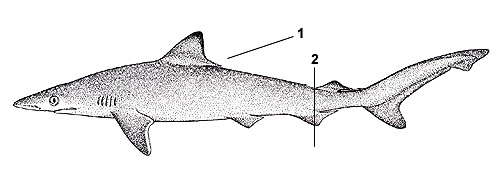
Distinguishing Characteristics
1. Dorsal surface has white spots in adults, the dorsal and caudal fins are edged in black on juveniles
2. Second dorsal fin originates over or behind midpoint of anal fin
Biology

Distinctive Features
The Atlantic sharpnose shark is considered a small species of shark. The prenarial snout is approximately 4% of the total length of the shark with long labial furrows noticeable at the corners of the mouth. The first dorsal is located directly over or slightly in front of the pectoral rear tips. The second dorsal fin originates above the middle of the anal fin.
Coloration
Several different shades of gray including olive, blue, and brown, are characteristic of the sharpnose’s dorsal area. Most adult specimens have white spots or splotches on their sides and white trailing the edges of the pectoral fins. Young sharks have black on the dorsal and caudal fin edges.
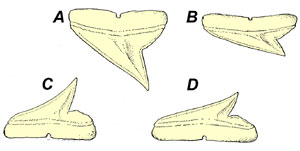
Dentition
The lower and upper jaw have 24 or 25 rows of similar teeth that are triangular and oblique with slightly notched outer margins. There are no distinctions between teeth of male and female specimens.
Denticles
Dermal denticles are small and closely spaced, overlapping with blades as wide as they are long. There are 3-5 low keels and 3-5 teeth on the posterior side of each blade.
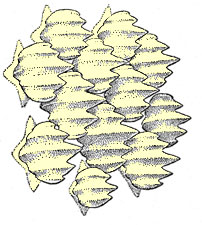
Size, Age, and Growth
Males of this species reach maturity between 2 and 2.4 years of age, at which time they average between 31.5-33.5 inches (80-85 cm) total length. Females reach sexual maturity at total lengths between 33.5-35.5 inches (85-90 cm), after 2.4-2.8 years. Maximum length of the Atlantic sharpnose shark is 43.3 inches (110 cm). At birth, the pups are 11.4-14.6 inches (29-37 cm) in length. On average, pups grow 2 inches (5 cm) a month during the first three months of life. The growth rate then slows to an average of .35 inches (0.9 cm) a month during the winter and spring months. Upon reaching lengths of 24-26 inches (60-65 cm), growth rates begin a linear increase of 0.5 inches (1.3 cm) a month for approximately a year. At this size, the sharks will also begin to form a distinct size class, which separates them from newborns.
Food Habits
This species feeds primarily on small bony fish, worms, shrimp, crabs, and mollusks. Bony fish include menhaden, eels, silversides, wrasses, jacks, toadfish, and filefish.
Reproduction
Mating occurs during late spring and early summer followed by the offshore migration of females during their pregnancy. After the 10-11 month gestation period, females return to nearshore areas to give birth. The number of pups in each litter varies, ranging between 4 and 7, and is related to the size of the mother. Atlantic sharpnose sharks are viviparous, providing nutrition to the pups through a placental sac. This species differs from other Carcharhinids in that the ovaries of the females develop on the left and the males have overlapping siphon sacs.
Predators
Any large carnivorous fish, including large sharks, is a potential predator of Rhizoprionodon terraenova.
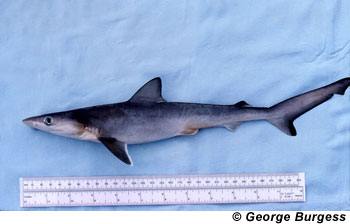
Taxonomy
Richardson first described the Atlantic sharpnose shark in Fauna Boreali Americana (1836) as Squalus terraenovae. It has also appeared in early scientific literature as Scoliodon terraenovae, Rhizoprionodon terraenova, and Rhizoprionodon terraenovae, all originating with Richardson in 1836. Currently, the valid name is Rhizoprionodon terraenovae (Richardson, 1836). The genus name Rhizoprionodon is derived from the Greek, “rhiza” = root, “prion” = saw, and “odous” = teeth. Terraenovae is from the Latin language, meaning “new land”.
Prepared by: Bryan Delius and Alexia Morgan